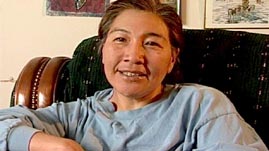Teachers' Domain - Digital Media for the Classroom and Professional Development
User: Preview

Source: International Institute for Sustainable Development/Hunters and Trappers Committee of Sachs Harbor



This video adapted from the International Institute for Sustainable Development profiles the Arctic Inuit community of Sachs Harbour and its collaboration with scientists studying climate change. Changes in the land, sea, and animals are readily apparent to the residents of Sachs Harbour—many of whom hunt, trap, and fish—because of their long-standing and intimate connection with their ecosystem. Scientists from a climate change study project interview the residents and record their observations. The scientists can use these firsthand accounts along with their own collected data to deepen their understanding of climate change in the polar region.
Analysis of scientific data reveals that the global climate is changing at a rapid pace, with nowhere more affected than Earth's polar regions. But these numerical data—which include measurements of summer and winter temperatures, precipitation, and extent of sea ice—do not tell us the complete story of the changes that are taking place. To more fully understand the effects of warming in the Arctic, scientists are turning to indigenous peoples, whose traditional subsistence strategies require a detailed understanding of the behavior of organisms and their response to environmental conditions. Their oral tradition and year-round activities provide unique insights into how the landscape, living things, and their very existence are changing.
For generations, Arctic communities such as the Sachs Harbour Inuvialuit people have hunted, trapped, and fished, following long-established routes over the ice and snow of the tundra. Because the people live and work in the community year-round, they experience the different weather and landscape each season brings. Through interviews, researchers can gain deeper observational insights that they can use to test different hypotheses and determine the cause behind the changes taking place.
Indigenous people provide more than just local knowledge: they provide a different way of understanding relationships. This comes from ancestral teachings that emphasized living as an interdependent part of the surroundings. In many ways, their methods for assessing their environment are consistent with the approach used by scientists around the world: the scientific process. Based on knowledge passed down through generations, indigenous peoples are aware when their environment begins to change. Using their recorded and analyzed observations, they propose explanations for what is happening. Because indigenous peoples observe subtleties not normally detected by advanced monitoring equipment, their pool of evidence may differ from—though still complement—that gathered by scientists who may not live in the region year-round.
For example, data from climate-monitoring equipment may show that the warm season during which sea ice can melt has lengthened at a rate of more than five days per decade over the past 30 years. Meanwhile, community members may report the incidence of thunderstorms, larger and more varied insect populations, and water that warms enough to permit swimming. Both kinds of observational evidence support the idea that the Arctic summer is warming.
The implications of climate change are both global and local in scale. Computer models suggest that continued warming in the Arctic region would lead to most of the permanent ice pack melting, thus opening the Arctic region to forms of resource exploitation not possible in the region before. On a global scale, a reduction in reflective ice cover would threaten to accelerate surface warming and change ocean circulation patterns. On a local scale, an Arctic meltdown would threaten populations of ice-dependent animals, including seals and polar bears. Because many indigenous Arctic people rely on these and other large mammals for food, their lifestyle and their culture may depend on their ability to adapt to a new scenario.
 Loading Standards
Loading Standards Teachers' Domain is proud to be a Pathways portal to the National Science Digital Library.
Teachers' Domain is proud to be a Pathways portal to the National Science Digital Library.
